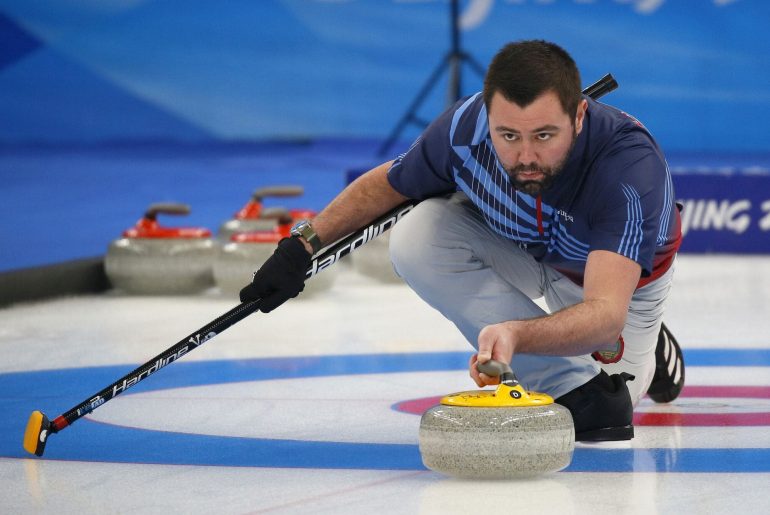How do I play curling
In order to play curling correctly, you absolutely need the curling rules. We have summarized these for you and explained them in detail so that there are no misunderstandings during the game.
Curling is an exciting and fast-paced game on the ice and is easy to learn and has some similarities to curling, ball sports, boules and bocce.
For precision and strategy sports, in which two teams, each with four players, play against each other on an ice rink (rink). The aim is to have one of your own stones placed closer to the tee (center of the target circle, also called the house) than the opposing team at the end of a round.
History of curling
The first attempts at curling date back to the late Middle Ages. The game was first mentioned in 1541 at Paisley Abbey in Renfrewshire. There, a Scottish admiral had converted his lucky charm into a token to push it across the ice. First, the game spread in Europe, later other regions followed and it became more and more popular. Thus, in 1716, the first curling club and the first rules of the game were created. At first, everything was still quite non-standard, quite unimaginable for today’s times. Those of you who are in Scotland can visit what is probably the heaviest stone in curling history: it weighed a whopping 58.5 kg. Most of the time, however, one played with stones from nature and more with luck than brains – also unimaginable today.
In 1880, curling fans could look forward to the first tournament at international level, and women have also been taking part since 1979. The success story of curling goes so far that it became an Olympic sport – in 1924 only as a demonstration competition, since 2006 it has been an official competition and subsequently Great Britain became the Olympic champion.
The basics
The lot decides who gets to start.
Each competition lasts between eight and ten rounds
A game is never undecided.
Curling is a gentleman’s sport, so there is no referee
The team
A team consists of four players who have a fifth player with them as a substitute.
Skip (captain)
Lead (plays the first two stones in the “end” (= round))
Second (plays the 3rd and 4th stone in the “end” (= round))
Third (plays the 5th and 6th stone in the “end” (= round))
Substitutes (test the stones for their “curl” with the coach and step in during the game if necessary)
The playing field
The curling field (“Sheet”) is 45.7 meters long and 5 meters wide. At the end of the playing field you will find a 3.6 m large target circle in the ice – the “house”. The rings of this target circle are used to determine how close a rock has been pushed to the center of the house.
The lines on the field are used for orientation and thus fulfill important tasks.
Behind the circle is the hack: used to push off the player after the throw. The “center line” starts from the middle and runs to the opposing “house” and connects the two tee lines. You can see this in the center of the target circle, which marks it (tee is the center of the circle),
In front of the circle you will find the “Hogline” (from one to the other it is 21.94 meters), which also delimits the “Free Guard Zone” up to the tee line. It marks the spot where you have to throw your stone at the latest. If you don’t, the stone is thrown out of the game.
The backline marks the end of the sheet. If a stone slips behind them, it flies out of play, as does crossing the sidelines on the right and left side.
The curling stone
On the top of the curling stone is a handle, which is usually the color of the team. The aim is, when you let go of it, to get it to “curl”, i.e. to turn or slide around curves. This allows you to “slip” the opposing guards.
Today’s curling stones are standardized and weigh a maximum of almost 20 kg, but there are also lighter models.
That’s how you play curling
Gameplay
The round is called “end” in curling jargon. The lot decides whether team A or B gets to start (by our explanation, A gets to start).
The lead of Team A plays the first stone by crouching down and kicking the stone in front of him. At the “Hogline” he has to let go of it at the latest and hope that he can place it well in the “House”. In order to have a better influence on this, another player on the team can help out with a curling broom to make the ice “more slippery”.
Thereafter
This is how you collect points
Your goal is to place your checkers as close to the center of the house as possible – and closer than the opposing team. The team that manages this wins the “End” and gets to place the first stone in the next round. Only one team can receive points at a time.
If you don’t agree on which stone is closer, use the measuring tape.
Winner
The team with the most points at the end of the competition wins. This is the case after 10 rounds provided there is a clear winner. But you can also give up or have to keep playing until a winner is determined.
What is the name of the stone in curling?
The rock you are playing with is called the “Stirling Stone”. Its name comes from the inscription on the oldest surviving curling stone: “St. Js B Stirling”.
How much does a curling stone cost?
Cheaper stones cost from 450 euros. If you want some from a granite factory, they can also cost up to 1300 euros
How heavy is a curling stone?
Minimum 17.24 kg (38 lbs) and maximum 19.96 kg (44 lbs).
How long does a curling game last?
You should plan a good two hours for a game, spread over eight or ten ends (passes).
Why do you wipe in curling?
The wiping melts the ice, which reduces the resistance between the Stirling stone and the ground. In this way, a lot of influence can be exerted on the result. It also cleans the playing field.
Why is the curling field irrigated with a kind of sprinkler during the break?
This also applies to improving the soil or ensuring that the stone cannot become stuck. The light spray creates small ice nubs that the stone can slide over because they act as a “buffer” between the ground and the stone.
How are team points determined?
You play ten separate ends (if no one gives up beforehand or you have agreed otherwise). At the end of each end there are points that you add up at the end of the game. You collect the points with your stones or where they are located.
Curling board games to play at home
If you are not fond of ice sports, you don’t have to do without curling fun. Various providers such as Engelhart, Noris and a few others offer curling board games. However, these only have one target circle, so you can curl your stones from the opposite side. The average cost factor is 20 to 35 euros.





